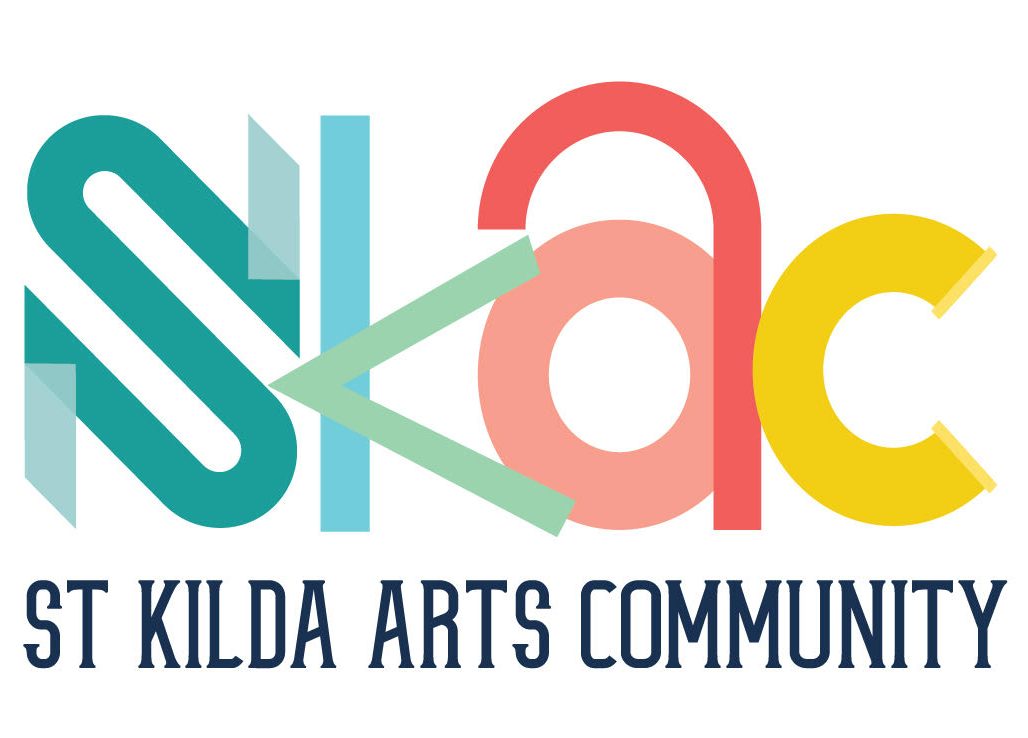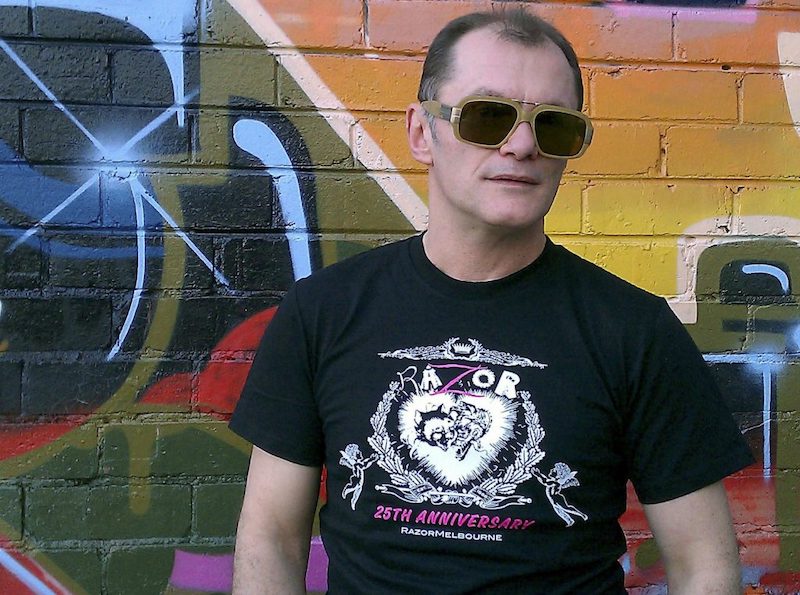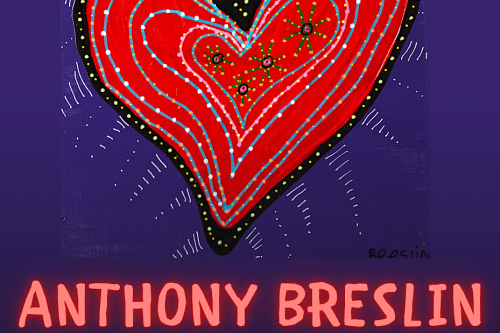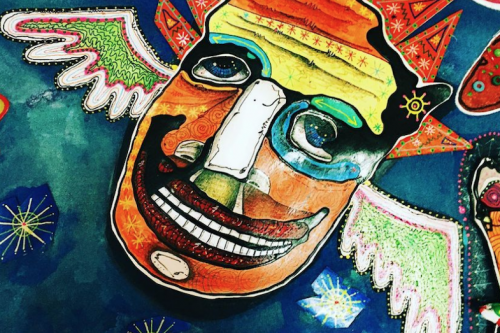by Roberto Chuter
St. Kilda’s legendary DJ, Gavin Campbell, is one of the most important and influential figures in the dance music and club scene in Australia. I was one of many, including a swag of Swinburne film students and actors that flocked to Campbell’s alternative club ‘Swelter’ downstairs at the old Matilda’s Bistro in Queen Street every week. In 1983 it was THE place to hang out and this was also the place where a variety of tribal music tastes were DJ’ed by Campbell for the first time.
Beginnings…
“I grew up in the Western suburbs and St. Paul’s College, Altona North is where I started secondary school, but I didn’t finish there. They wanted me out. What happened there was if you got a demerit it was bad, you had to do something really bad to get one. And if you got 10 in your whole six years there, like when you got the tenth you were expelled automatically. And I got 9, towards the end of Year 9, third form. And the Dean called me into his office and I said “Mum doesn’t like this school anymore. She doesn’t want me to be here.
She thinks I am getting too rough. So she’s going to pull me out at the end of the year”. So he simply said okay. It was a bit of a slack final term that year. Then I went to Geelong College, which is obviously a well appointed school, very expensive. Mum fought with Dad tooth and nail to pay the fees but I wanted to do drama, I wanted to act. I did all the drama classes and all that kind of stuff. English literature was a big thing with me. I didn’t fancy my chances at H.S.C. (which was Year 12 at the time) because it was heavily based on exams and I got nervous about that so I left and did T.O.P. at Preston Technical College which was a TAFFE course. I went there specially because they had drama and cinema studies with Tom Ryan, the famous Australian film critic, he was one of the main lecturers.
My connection with Tom and a couple of other drama teachers ended with me going to Melbourne State College to study teaching which had more cinema and more drama. I began fooling around and was not very disciplined in my teacher’s course so I left. I started hanging around the band scene in St. Kilda. A very dear friend was the musician Mark Seymour from the rock band‘ Hunters and Collectors’. That was the sort of scene I was hanging out in.and I actually knew Mark from Melbourne State College. He was there doing final year and one of his early girlfriends was in my year. So I connected with Mark and we became very good friends and we used to intellectualise about music and other stuff. It was his influence and another person from Melbourne State College, Craig Pearce, who at the time was a celebrated music journalist, (he also happened to be my housemate), so I became confident and said I think I am going to DJ now. I was good at that, so it took over from acting”.
An originator, DJ, producer and label owner, Campbell became the founder and co-founder of landmark underground and mainstream Melbourne clubs of the 1980’s – 2000’s. In the early 80’s there were some glitzy mainstream discos along King Street for the footballer set, but nothing for Melbourne’s alternative crowd when Campbell started ‘Swelter’ with Craig Pearce. He pioneered the introduction of cutting edge strains of house, techno and other new music to the hordes of hungry patrons. With a finely tuned archaeological ear as a DJ, he interspersed sets with deep-cut discoveries across genres including disco, funk and and created seminal cultural waves that still reverberate even today. Though his tireless pursuit of musical perfection during his years of prolific creating, the past couple of years have noted an auspicious return to form with music in the charts, exciting collaborations and the renaissance of his label, Razor Recordings.
Could you tell more about the seminal nightclub ‘Razor’?
“I created it in 1986 with Jules Taylor, a fellow club promoter (and club rival) who was a very close friend of mine. Jules and I, we had drug problems at the time. St. Kilda was a very druggy music scene, and we weren’t doing too well. So we wanted to open a club together because I had ‘Swelter’ and she had ‘Hardware’. We join forces to make some money and go to America and get away from drugs and drive from L..A. to New York – you know that kind of romantic ideal so we found a venue with an old-fashioned club licence, the old art deco ‘Light Car Club of Australia’ in Queen’s Road (now demolished). After a few months, Jules left and so I asked my partner from ‘Swelter’, Andrea Treble to join me at ‘Razor’, as the club had become very special and I needed help. I was stuck in the DJ booth a lot in those early days. I continued to run ’Razor’, with Andrea mainly, for the next five years.”

‘Razor’ represented the beginning of the underground in the modern Melbourne club scene. It was the first club in the 80’s to offer an alternative to the music played in existing nightclubs, other than Euro disco and commercial Top 40. There were a few other alternative styled club nights, however, they were usually short lived. The music at ‘Razor’ attracted the arts and fashion industries as well as the music scene on both sides of the Yarra, from St. Kilda and Fitzroy mainly.
“The club was credited with being the world’s coolest of its time as the likes of Bono, Michael Hutchence and Sting attested. It was never about being seen. It was always about the music for those who mingled joyously in the multi-storied art deco building where ‘Razor’ existed every Friday night from 1.00 am. Celebrities were free there to be just another face in the crowd. INXS used to go there after their gigs. They even spoke about the club n interviews around the world. Michael loved the club. There was a bunch of pop stars, unofficial ambassadors for our club, they thought it was the bees knees and they knew it because they travelled – ‘Crowded House’, Kylie, Michael, Gus Till, Ollie Olsen, ‘MaxQ’ – all kinds of people that were regular travellers overseas would like to brag about this really cool club ‘Razor’ attracting other stars to come over for the experience,” Campbell said.

“The creatives flocked to ‘Razor’, without any need for promotion because of the eclecticism and style with the music choices, along with the mix of colourful and interesting people like George Huxley, Gavin Brown, Ash Wednesday, Sam Sejavaka, Hugo Race, Kerri Simpson and many others. Ironic really, when you consider that throughout this whole time, the other nightclubs in Melbourne were tripping over themselves trying to attract the same crowd as ‘Razor’. It was a hopeless endeavour because they were never adventurous enough with their music policies. For the ‘Razor’ dancefloor, I could quite literally go shopping for records on a Friday, pick up the most cutting-edge club music from overseas and then program up to 20 new songs that same night at ‘Razor’, with all of it packing the floor. ‘Razor’ was always ahead of the pack. Fresh club sounds from overseas mixed with edgy 70’s and 80’s funk, soul, disco, post-punk and hip hop/rap, James Brown and Prince, played mostly by Paul Main, Guy Uppiah, Sean Kelly and myself, along with 3RRR soul show presenters Jo Brady and Kate Seeley warming up every week. House music started to seep into the mix toward the end of 1987 and really took over by the time ‘Razor’ closed in 1992”.
In 1989 Campbell founded Razor Records when he licensed a pair of old disco hits from the U.S., “Dance Across The Floor” and “You Get Me Hot”, both by Jimmy Bo Horne. The label was then picked up by Mushroom Records in Melbourne and ‘Razor’ started to make its own dance music. Its historic moment came through Filthy Lucre which consisted of Campbell, Robert Goodge (of 80’s band ‘I’m Talking’) and DJ Paul Main, who together made Australia’s first international club hit with their remix of Yothu Yindi’s ‘Treaty’. It was awarded “Song Of The Year” at the 1991 ARIA’s and was the fifth biggest-selling Australian record of the year. Campbell and Main were the first Australian DJs to achieve an ARIA-certified Gold Record, as well as an ARIA nomination, in the Best Producer category.
In 1992, Campbell opened ‘Tasty’ at the Commerce Club (in Flinders Street) – an alternative queer dance club way before its time – so much before its time that on the 7th August 1994, Victoria Police raided the club. They forcibly stripped searched all 463 patrons and staff, some even were cavity-searched and people were detained illegally for seven hours. The exact police motivation for the raid is unclear. The reaction after was a moment that changed gay rights, some described it as Melbourne’s Stonewell. The reaction also changed the rights of those attending music events with politicians acknowledging the extremity and brutality of the raid. The incident led to successful legal action against Victoria Police with damages awarded to many patrons.

In the ensuing decade, Campbell created landmark clubs such as ‘Savage’, ‘Temple’, ‘Bump!’ and ‘Uranus’, as well as a successful stint as co-creator, musical director and resident DJ at ‘Poof Doof’. He currently holds down a long-term residency at world renowned Sydney/Melbourne quarterly Techno event, ‘Trough X’, Melbourne’s South-side disco quarterly, ‘Disco 3183’ and is a regular guest at Thursday cult night dance clubs ‘Honcho Disko’ and ‘New Guernica’.
‘The Treaty’ 25th Anniversary remix project in 2017, spent six months on the ARIA club chart, resulting in Campbell spearheading a new live show with one of Australia’s most internationally recognised aboriginal bands, ‘Yothu Yindi & The Treaty Project’. Campbell performs with YYTTP onstage, using a Toraiz SP-16 sampler, Ableton Live and also live percussion, with the outfit having appeared at several music, arts and First Nations festivals across Australia and New Zealand including Sydney Opera House, Victorian Arts Centre,Commonwealth Games Festival, Adelaide Fringe, Byron Bay Bluesfest, Strawberry Fields, Queenscliff Music Festival and NZ’s Waitangi Festival.
I asked Campbell why he does the work he does…
“I’ve loved sharing music and hosting people since the 1970 at home and community social gatherings and events. I combined the two as a DJ and promoter in the 80’s and 90’s, which seemed a natural progression and evolution for me. I do this work because it’s always been in my blood”.
Who are some of the artists or some of the works that inspired you to get started?
“Growing up, I was very much into music and theatre. In the early 70’s it was the ‘Jackson 5’ and early Australian music shows on television, like ‘Happening 68, 69 and 70’. Standout events growing up included “Jesus Christ Superstar”, AC/DC (many times from ’73-‘77), Suzi Quatro (Festival Hall ’74) “Tommy” (Ken Russell’s film ’75), Queen Live (Festival Hall ’76) and then, in the 1980’s – Grace Jones, Iggy Pop, ‘Talking Heads’ and ‘The Birthday Party’ and Prince (music in the 1980’s, live in the 1990’s). The current artists I really admire are bands like ‘Arcade Fire’, Sampa The Great, Daft Punk, Hot Chip, Todd Terje and Emma Donovan. My DJ crushes include Carl Cox, Maceo Plex, Patrice Baumel, The Black Madonna, my main DJ influences have been Stephen Allkins (Sydney) and Frankie Knuckles (Chicago) and fave Australian DJs are Phil K, Guy Uppia, Stephen Allkins and Late Nite Tuff Guy”.
What have been some of the negatives in your work?
“Drugs, alcohol and late, late nights are all occupational hazards and even when one doesn’t indulge personally, these things still affect you because everyone else around you is high. No judgement, it’s just that it really tests your patience. It’s a double-edged sword really, as the positives also include the experience of everyone having fun because you’re entertaining them. A definite positive is playing songs that I’ve personally had a hand in creating. When the dancefloor is packed and going off, it’s especially satisfying”.
What have been your favourite completed projects up to this point?
“The recent remixes of Yothu Yindi’s ‘Treaty’ has been my fave recent project, in terms of music production and the songs continuing relevance to Australian culture and politics. The stand-out anniversary remixes were from Carl Cox, Baker Boy and The Journey and I also expanded his production outfit Filthy Lucre (including DJ/producer Nick Coleman and multi-instrumentalist and Circus Oz musical director Ania Reynolds) for a couple of new remixes. We also created several new remixes for a series of live Yothu Yindi & The Treaty Project shows, resulting from the success of the ‘Treaty’ anniversary package”.
What projects are you currently working on or have lined up for the near future?
“Robert Goodge (original Filthy Lucre co-producer) and I have recently returned to the studio together, again under our Filthy Lucre moniker, to produce a new remix for his seminal Australian dance band “I’m Talking”. We remixed the band’s classic 1985 hit ‘Holy Word’, along with other current remixers Dr. Packer and Jolyon Petch. And we’re currently working on new material”.
Where do you see yourself in a few years and what would it take for you to consider your career a success?
“In a few years I want to still be producing music for myself and others, along with occasional DJ gigs and perhaps more live shows for Yothu Yindi & The Treaty Project. I’m also writing my memoir. I regard success for myself as being measured in terms of the influence and the activities in which I’ve been involved. Many of the projects I’ve done happened at a time when other people were not yet active in those areas. I’ve been a bit of a trailblazer in that respect. Therefore, my work is often regarded as being influential, or seminal and has been inspiring for others”.
If you couldn’t do this anymore, what career path do you think you would have followed?
“I think I would’ve been a chef. I love being creative with food, cooking for people and hosting. I can see myself with a bar/café or perhaps even a restaurant. I think I would’ve still found myself in the hospitality or night economy industry, as I take after my mother, in that, I’m very much a night owl?”
Could you tell us a funny story or joke that involves your work?
“Once, in 1985, I was DJing at ‘Chasers’ on a packed Saturday night. I really needed a piss, so I put on a very popular, long song (“Teardrops” by Womack & Womack), so that the floor would still be packed when I got back to the decks. Unusually, this particular 12” single included a shorter radio version as track on side one, as track one (followed by the extended version). I was at the urinal, right down the back of the club, when I heard the song fade to nothing, which meant that I first had to finish and quickly run through the entire club, to get back to the booth and continue the music, which seemed like an eternity. Needless to say, management was not happy. ‘Chasers’ and I concluded that I was much better suited to running my own club nights where I could actually be free, to be me, rather than being a promotional tool for their mainstream crowds and we parted ways. I find it funny because I really need to do my own thing and it’s better to be celebrated for that but I was sacked instead!”
Gavin Campbell’s contribution to the Australian music industry is absolutely irreproachable. He is a person of great enthusiasm, of genuine warmth and is humorous and enterprising to boot. He possesses a rare bouquet of eclectic talents, and he is astoundingly prolific only to become justifiable so – a Melbourne legend, a much loved DJ who refuses to be ordinary. Thankfully.
Postscript: There is an added bonus too, he is a huge Prince fan!





